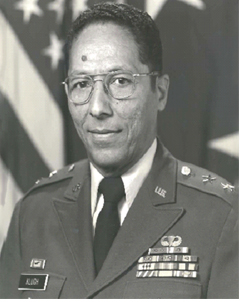Major General
James R. Klugh
 Born June 22, 1931, in
Greenwood, South Carolina, James R. Klugh graduated from South Carolina State College in 1954 with a Bachelor of
Science in Chemistry and a commission as an Infantry second lieutenant through ROTC. He was an Infantry officer
until 1960, completing the Infantry Officer Basic and Advanced Courses; commanding Company D, 16th Battalion, 4th
Training Brigade, Fort Jackson, South Carolina; and serving in a variety of troop and staff assignments with the
516th Airborne Infantry, the 7th Infantry Division, and the 1st Infantry Division.
Born June 22, 1931, in
Greenwood, South Carolina, James R. Klugh graduated from South Carolina State College in 1954 with a Bachelor of
Science in Chemistry and a commission as an Infantry second lieutenant through ROTC. He was an Infantry officer
until 1960, completing the Infantry Officer Basic and Advanced Courses; commanding Company D, 16th Battalion, 4th
Training Brigade, Fort Jackson, South Carolina; and serving in a variety of troop and staff assignments with the
516th Airborne Infantry, the 7th Infantry Division, and the 1st Infantry Division.
In 1960, Klugh received a Regular Army commission and a branch transfer to the Chemical Corps, where he served in a series of important positions in the V Corps Chemical Section in Germany; at Edgewood Arsenal, Maryland; and as the Division Chemical Officer in the 101st Airborne Division (Airmobile) in Vietnam. His assignments were not all specific to the Chemical Corps, as he also served as Executive Officer in the 1st Brigade, 2nd Armored Division, and then commanded the Division's 502nd Supply and Transportation Battalion at Fort Hood, Texas, from 1971 to 1973.
With the disestablishment of the Chemical Corps in 1973, Klugh would again prove his versatility by embarking on a career in yet another branch--the Ordnance Corps. Graduating from the Army War College as an Ordnance lieutenant colonel in 1975, he was hand picked to serve as Chief of Staff of the US Army Tank and Automotive Command, where he resolved major problems and improved the Command's relations with higher headquarters. He next commanded Dugway Proving Ground, Utah, from 1977 to 1979. He then served as a division chief and then as Deputy Director, Officer Personnel Management Division, US Army Military Personnel Center, Alexandria, Virginia, from 1979 to 1983.
Klugh was selected by the Commander, US Army Logistics Center, Fort Lee, Virginia, to serve there as Deputy Commander for Training Development. In this position, he developed the organization, doctrine, and equipment requirements for the logistics elements of the Army's light divisions. Promoted to brigadier general in October 1983 while at Fort Lee, Klugh went on to hold a series of demanding command and staff positions from 1984 to 1990, including Deputy Commanding General, Chemical Materiel, US Army Armament, Munitions and Chemical Command at Rock Island, Illinois; Commanding General, US Army Chemical Research and Development Center, Aberdeen Proving Ground, Maryland; Deputy Chief of Staff for Personnel, US Army Materiel Command, Alexandria, Virginia; and Assistant Deputy Chief in the Office of the Deputy Chief of Staff for Logistics, Washington, DC. He was also appointed Deputy Under Secretary of Defense for Logistics, where he was instrumental in establishing the Department of Defense Total Asset Visibility Program, a global system for tracking the status of in-transit personnel, equipment, and supplies. In addition, he led the development of Interactive Electronic Technical Manuals, digitized versions of maintenance and operations manuals. Maj. Gen. James R. Klugh retired in 1990 after more than 36 years of service and a record of excellence in a range of branches and assignments that few can match.